Mount Ellinor, Olympic National Forest
March 12, 2005
In search of some exercise to break up the monotony of grading exams, I headed out to the southeastern corner of Olympic National Forest to climb up Mount Ellinor under blue skies. I had been up Ellinor in September of 2004, but the visibility had been about a dozen feet and I wanted to see what I had missed on my first trip in the area. There was only one other car at the lower trail head and mine made two. I hoped for a quiet hike, but knew that most people would drive to the upper trail head and cut off some work from their climb.
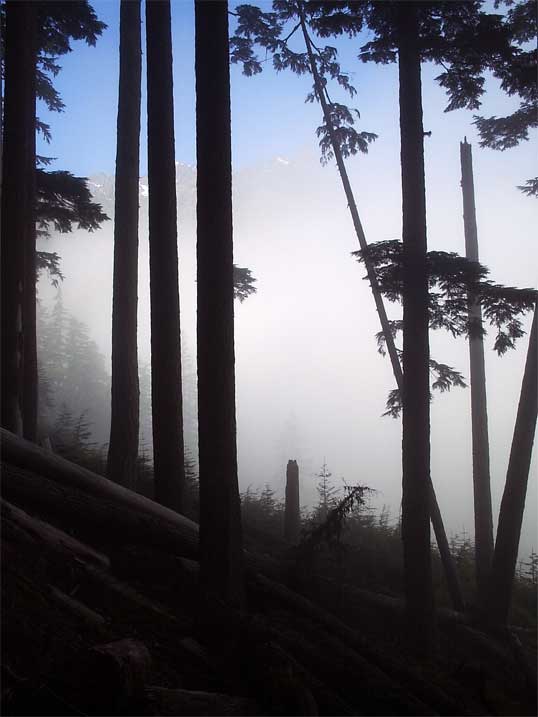
Light, thin clouds were draped on the edge of the mountains, but I could see bits of blue higher up and was confident that I wouldn't repeat my previous trip.
The clouds gave the air some texture and produced interesting effects in combination with the sun.

Shortly after passing the junction with the trail to the upper trail head, I began hearing voices. Two Canadians were passed. Then, three women hikers. Another couple. It looked like it was going to be a crowded day at the top. Although sweat was falling off me in buckets and I was breathing hard, the hike up wasn't especially tiring, although this is a matter of perspective. I passed another three hikers resting at a trail junction with "The Chute", a winter scramble up a gully to the top. I passed it and ran into my first snow, although it was hard packed and easy to move along. I passed a couple struggling on a snow patch and then finally broke out into the open. Three hikers were resting in the open area as I walked on by. A few long, inclined snow fields were easily traversed, although I wished I had my ice axe for a little extra safety. A broken down hiker was resting near a rock on one of these snowfields. I passed another two hikers wheezing their way up some rocks and then another three on a beautifully constructed trail leading right up the side of a minor peak.
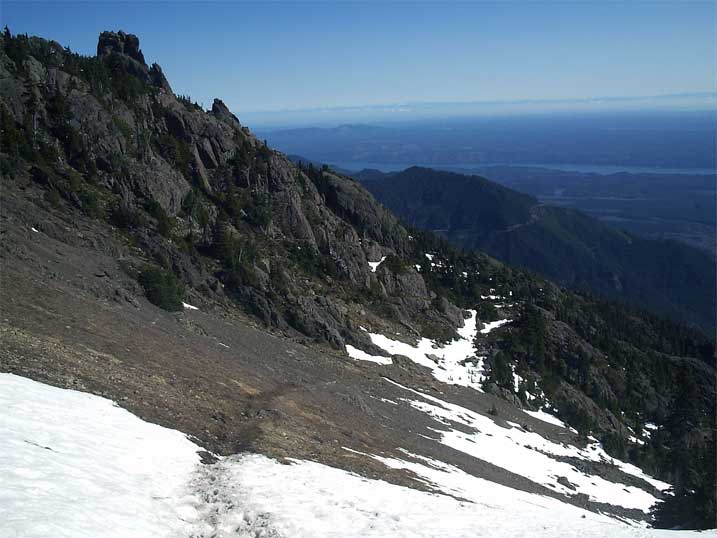
I felt sorry for these last few hikers, for it looked like the top was near. However, when you get to the end of the beautiful trail, you are only at a minor pass and still have several hundred vertical feet left to climb. I pushed on up the trail and found two hikers resting in the shade of a tree. They must have thought me quite a mess as when I said hello, sweat flew off my face and they chuckled. A snow field, or two, and I was at the top, as were five other hikers.
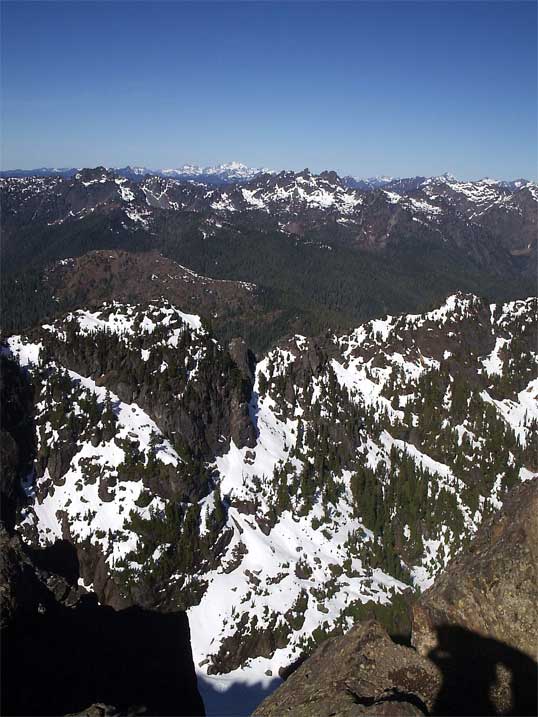
On the other side of Ellinor I could see many of the peaks and areas that I had been playing on and in for the past few months. Mount Cruiser and Cub Peak, and in the far, far distance sat the majestic Mount Olympus. I talked with a few of the hikers at the top for a while before finding a nice seat in the sun for some lunch. All the big guys of the Cascades were out on the horizon. Mounts Baker, Rainier, St. Helens, and Adams were clear as day. Glacier Peak stood up along with the other smaller mountains in the Monte Cristo group. Long, blue Lake Cushman was far in the valley below and the finger of Hood Canal ran out forever. Through the haze on the other side of Puget Sound, the metropolis of Seattle could be spotted. As could the clear cut valleys on the floor below me and the parking lot of the upper trail head, jammed with cars.
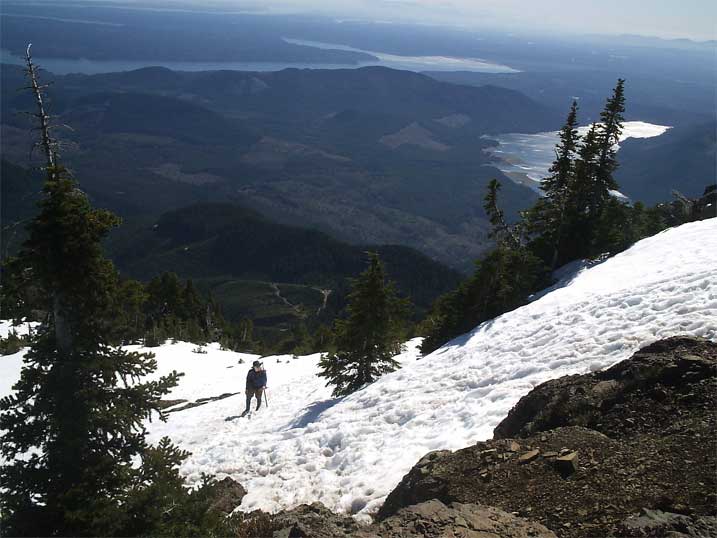
Some of the hikers I had passed on the way up began to straggle in looking tired but in good spirits. Some began to taunt each other with how long it took them to get up. I didn't bother to volunteer that I had come up from the lower trail head and got to the top in forty fewer minutes than the most vocal of them. Someone's cell phone rang, though thankfully the hiker that belonged to it didn't get much past, "Guess where I am!" I dropped a few feet off the top to a little bench where I could be out of sight and mostly out of ear shot.
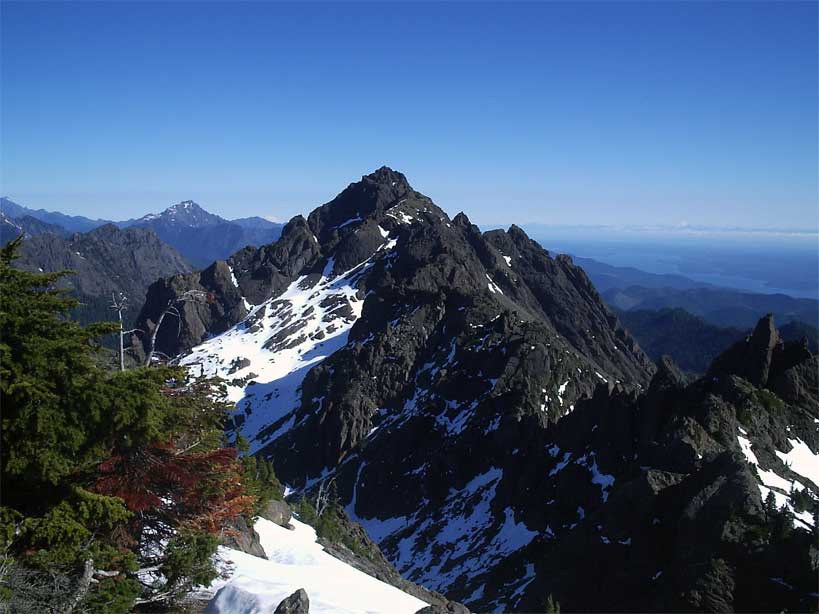
I was glad that people were coming out to Mount Ellinor and enjoying their land. If more people come out, perhaps when an environmental issue comes up they'll support it because they have a stake in the outcome. This is why environmental movements frequently fail: When push comes to shove, those with a stake in something tend to defeat those who do not. Miners, loggers, and developers all have a stake. Miners, loggers, and developers usually win. Any move to increase the number of people in the outdoors helps the environment by making it a part of people's lives. Restricting the number of people or making it difficult for them to access their own land doesn't do the land any good. In spite of my happiness that so many people were out here, I reminded myself that next time I needed to start an hour early and so that I could have the entire place to myself.

Logistics
From Lakewood, drive I-5 south to HWY 101 and take this through Shelton to the town of Hoodsport. In the middle of town, make a left onto SR 119 at the signed junction and head toward Lake Cushman - Staircase. Drive about 11 miles to where SR 119 hits a T-junction. To the left is Staircase. Make a right and drive about 1.5 miles on a good gravel road (a few potholes) and then make a left turn on yet another gravel road. There isn't a sign, but the road is hard to miss and there is a sign (in the other direction) just past it. Drive up about 5 miles to the lower trailhead, which has a sign on it. The road is narrow, but is in good shape and my Camry had no problem with it. Continue on the road for another two miles to reach the upper trail head. You'll need a Northwest Forest Pass or other parking permit (like a Golden Eagle Passport) or risk getting a ticket.
From the lower trail head to the top is a bit of a grunt. Two guidebooks list the distance at about 3 miles, but I think this is a little short (not by too much). Vertical gain is about 3200 feet, so the hike is a bit stiff. Starting at the upper trail head cuts off about 1.5 miles and a thousand or so feet of gain. It took me about 80 minutes to get up to the top from the lower trailhead and about 80 minutes to get down. No special skills are needed to get to the top and this would make a great hike for someone in shape, but not used to exposure.







